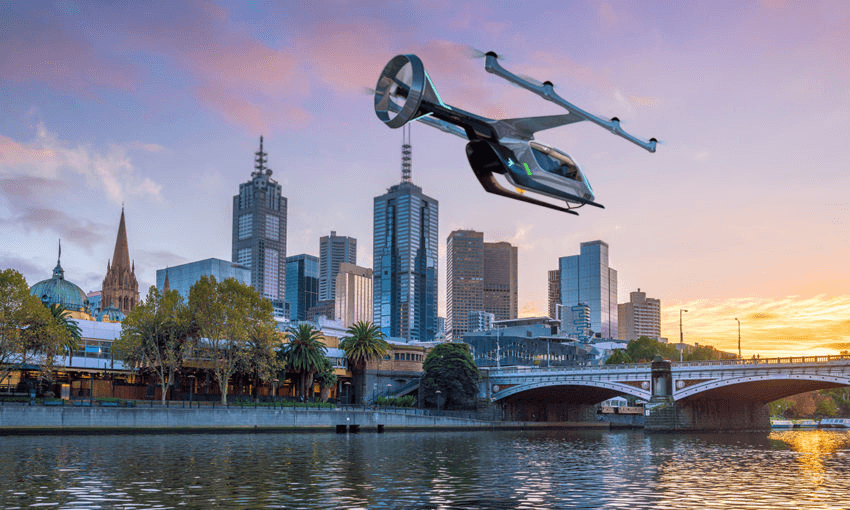Melbourne joins two American cities as launch markets for Uber air taxis, part of plans to add a ‘third dimension’ to its ride-hailing services
Uber users could be travelling by air around Melbourne as soon as 2023 under plans announced today. The Australian city was named as the third pilot market for Uber Air, and the first outside the US.
Melbourne joins Los Angeles and Dallas Fort Worth in a programme the company hopes to grow into a “global aerial ride-sharing network”. The goal is to introduce demonstration flights in the three cities in 2020, with Uber Air launching commercially three years later.
The company said it wants to see the pilot programme grow into a service which carries “tens of thousands of people across cities for the same price as an UberX trip over the same distance”.
Uber Air relies on the creation of a new generation of aircraft – most of which look like the offspring of a small plane and a helicopter – that are electric-powered and able to take-off and land vertically, usually from the rooftops of commercial buildings. Riders would combine a shared airborne component with existing Uber car services.
The announcement was made as part of the third Uber Elevate Summit, at the Ronald Regan Building in Washington DC. The event, a mix of conference and product launch, includes speakers from Uber, regulators and politicians, including Senator Ted Cruz. Prototypes of the aircraft being developed by partner companies are on display.
Revealing the decision to name Melbourne as the third pilot city, the general manager of Uber in Australia, New Zealand and North Asia, Susan Anderson, praised Australian state governments’ “forward-looking approach to ridesharing and future transport technology”. Another critical consideration had been “Melbourne’s unique demographic and geospatial factors, and culture of innovation and technology”.
Uber announced that it would partner with the Australian company Macquarie Capital to begin work on developing facilities or “skyports” for takeoff and landing, with Telstra for network infrastructure and Scentre Group, which owns the Westfield chain in Australia and New Zealand, for skyport sites.
Anderson said they were committed to working collaboratively towards “an urban aviation rideshare network that is safe, quiet, environmentally conscious and supports multi-modal transport options”.
Representatives from the Victorian state government attended the summit, while Uber had flown (by conventional means) a contingent of Australian and New Zealand media, including the Spinoff, to Washington for the event.
Speakers from Uber emphasised that their airborne ambitions were a critical part of a shift from a road-focused company to one focused on transportation across the board, from scooters to flying cars. They surveyed the technological, safety, environmental and regulatory challenges that needed to be overcome to make the 2023 goal of commercial operations in three cities a reality.
The presentations began with a montage including the obligatory clip from The Jetsons, along with another from Back to the Future. That’s despite there being no suggestion of any time-travelling vehicle in development – even if some of the proposed designs for future-skyports do have a decidedly science-fiction flavour.
The idea of the flying car has of course been around for many decades – and has reliably failed to meet promises of its imminence. As if to front-foot scepticism around that 2023 target, Uber’s head of elevation, Eric Allison, addressed the crowd of about 1000 people in front of a projection reading, “Urban Air Mobility – it’s closer than you think”.Allison said the challenge was to “take our mass, our scale on the ground” and use it to efficiently patch together journeys using a range of vehicles, aircraft among them, “making this multi-modal problem much simpler”.
It was no coincidence, he said, that they had chosen to host the summit in Washington DC, given the importance of securing regulatory changes that would make Uber Air possible.
Allison said he envisaged urban flying to before long be cheaper than owning a car. “Our vision is that on a daily basis, it will be more economically rational for you to fly than you to drive.”
A number of manufacturers are developing electric vertical takeoff and landing, or eVOTL, aircraft as part of Uber’s plans. It was “the most exciting time in aviation since the dawn of the jet age”, said Pete Bunce, head of US General Aviation Manufacturers Association.
At the Elevate Summit a year earlier, the company announced that it was seeking a third international city to join Los Angeles and Dallas Fort Worth in the launch programme. It hinted then, “Could an Aussie or New Zealand city be the lucky one chosen?” The chances of a New Zealand city being named alongside the American metropolises always looked paper-thin, but that was underscored by last month’s announcement that Uber would close its Auckland office, with around 20 jobs moving to the Sydney regional HQ.
A rival air-taxi project, Cora, backed by Google co-founder Larry Page, is testing self-flying vehicles in New Zealand. In October last year it announced a partnership with Air New Zealand as part of a plan to “bring the first ever air taxi service to the sky”.
Uber has endured a turbulent month, with its share price taking a tumble following a long-awaited IPO. The company, which is yet to register a profit, has since seen the departures of two senior executives, including chief operating officer Barney Harford, who had originally been slated to speak at the Washington DC summit.
